Whether you’re dealing with challenging terrain or windy conditions, having an effective coyote call can make all the difference in your hunt. Electronic predator calls, with their ability to project sound over long distances, are a reliable choice. Meanwhile, open reed and mouth calls remain popular for their versatility and effectiveness. In my 20 years of coyote hunting, I’ve found that the most successful predator hunters rarely head out without both types of calls in their gear.
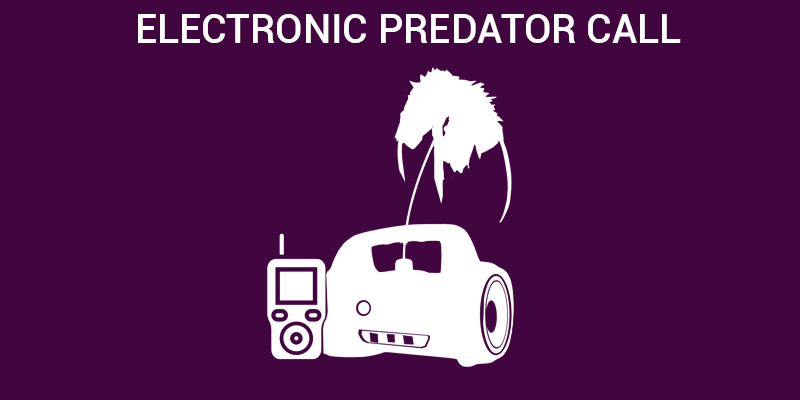
Each has its own strengths, and being prepared with a variety of calls ensures you’re ready for any situation whether you’re dealing with a cautious coyote hanging back or one charging straight in. With advancements in technology, today’s predator electronic calls offer unparalleled sound clarity, making them far superior to the ones used in the past. Choosing the right coyotes call can be tricky, so I’ve put together a list of the best electronic predator calls for beginners to help you get started this season.
Overview Of The Best Predator Call
1. Icotec Electronic Predator Call
Our Pick
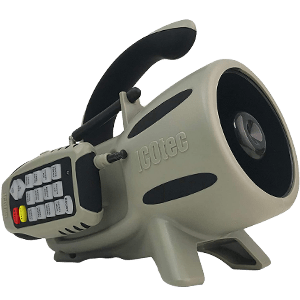
⚙ Product Specifications
- 300-yard remote range
- High fidelity sound technology
- 15 professional sounds included
- Backlit buttons for night hunting
2. FOXPRO Prowler Electronic Predator Call
Best Budget
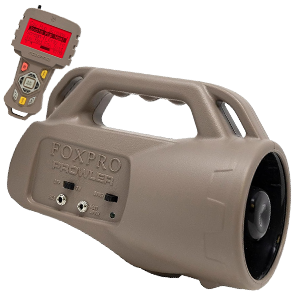
⚙ Product Specifications
- 175+ sounds, can hold up to 300
- Elastomeric keypad
- High-efficiency horn speaker
- External speaker and auxiliary jacks
- 4 AA batteries.
- USB port for reprogramming sounds
3. Primos Hunting Electronic Predator Call
Budget One
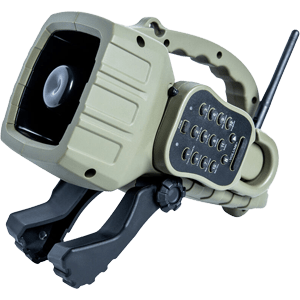
⚙ Product Specifications
- Remote range 100 yards
- 12 proven Randy Anderson sounds.
- Can play two sounds simultaneously
- Adjustable legs helps direct sound into the air
- Requires 4 AA batteries
4. Lucky Duck Rebel Predator Call
Feature Loaded
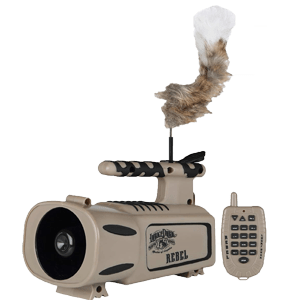
⚙ Product Specifications
- 12 predator-enticing sounds by Rick Paillet
- Motorized decoy included
- Long-range remote up to 300 feet, no line of sight needed.
- Caller uses 10 AA batteries; remote uses a 12V 23A battery
5. iHunt Electronic Predator Call
Innovative
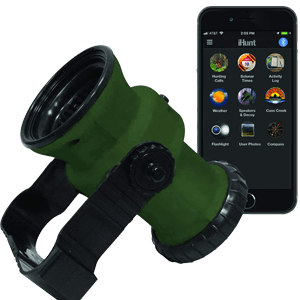
⚙ Product Specifications
- 750 animal calls for 59 species
- Free app for control & customization
- 115-decibel loudspeaker
- Bluetooth range up to 50 yards
- Uses 4 C batteries
6. MOJO Predator Call
Cheap One

⚙ Product Specifications
- 80 proven sounds
- Magnetically connected, remote-controlled MOJO Critter Decoy
- Remote range up to 300 yards
- High-quality cone speaker, max volume 120 decibels
- Uses 8 AA batteries
What is Electronic Predator Call?
An electronic predator call is a device used by hunters to attract predators like coyotes, foxes, and bobcats. Here are some key points about electronic predator calls:
- Realistic Sounds: They play pre-recorded animal sounds, such as distress calls or mating calls, to lure predators.
- Remote Operation: Many models come with remote controls, allowing hunters to operate them from a distance.
- Programmable: Some calls can be programmed with different sounds and sequences to suit various hunting scenarios.
- Hands-Free: They free up the hunter’s hands and eyes to focus on spotting and aiming at the predator.
- Durability: Designed to be rugged and weather-resistant for outdoor use,
How We Picked The Best Coyote Calls?
When selecting the best coyote calls, I focused on several key factors to ensure a comprehensive and practical review. Here’s a detailed breakdown of the criteria I used:
1. Ease of Use
User-Friendly Design: Calls that are easy to operate, even for beginners, were prioritized.
Intuitive Controls: Remotes and buttons that are simple to understand and use, especially in low-light conditions.
2. Sound Quality
Realism: The calls needed to produce lifelike sounds that effectively attract coyotes.
Volume and Clarity: Ensuring the sounds are loud enough to cover long distances and clear enough to avoid confusion.
3. Battery Life
Longevity: Calls with longer battery life were favored to ensure they last through extended hunts.
Battery Type: Preference was given to calls that use common, easily replaceable batteries.
4. Remote Distance
Range: A longer remote range allows hunters to stay hidden while operating the call, increasing the chances of a successful hunt.
Reliability: Remotes that work consistently without needing a direct line of sight.
5. Speaker Clarity
High-Quality Speakers: Ensuring the calls are loud and clear enough to be heard over long distances and in various terrains.
6. Additional Features
Programmability: The ability to upload and customize sounds adds versatility.
Decoys: Integrated decoys can enhance the effectiveness of the call.
Portability: Compact and lightweight designs are easier to carry in the field.
7. Price
Budget Considerations: Finding calls that offer the best features within a specific budget.
Value for Money: Considering the overall value, including durability, sound quality, and additional features.
8. User Reviews and Recommendations
Feedback: Reviews from other hunters provide insights into real-world performance.
Expert Opinions: Recommendations from experienced hunters and experts add credibility.
By considering these factors, I aimed to select the most effective and reliable coyote calls for different hunting needs and budgets.
Things to Consider Before Buying a Coyote Call
When choosing a coyote call, there are several important factors to consider to ensure you get the best results for your hunting needs. Here are the key points to keep in mind:
1. Type of Call
Electronic vs. Mouth Calls: Electronic calls are user-friendly and come with a variety of pre-recorded sounds, while mouth calls require more skill but can be more versatile in the field.
2. Sound Quality and Range
Realism: The call should produce realistic sounds to effectively attract coyotes.
Range: Ensure the call can reach the distances you need, especially in open terrains.
3. Remote Control
Range: A longer remote range allows you to stay hidden while operating the call.
Ease of Use: Look for remotes with intuitive controls and backlit buttons for night use.
4. Battery Life
Longevity: Consider how long the call can operate on a single set of batteries, especially for extended hunts.
Type of Batteries: Check if the call uses easily replaceable batteries.
5. Durability
Weather Resistance: The call should be able to withstand various weather conditions.
Build Quality: Look for rugged designs that can handle rough outdoor use.
6. Additional Features
Programmability: Some calls allow you to upload and customize sounds.
Decoys: Integrated decoys can enhance the effectiveness of the call.
Portability: Compact and lightweight designs are easier to carry in the field.
7. Price
Budget: Determine your budget and find a call that offers the best features within that range.
Value for Money: Consider the overall value, including durability, sound quality, and additional features.
8. User Reviews and Recommendations
Feedback: Check reviews from other hunters to see how the call performs in real-world conditions.
Expert Opinions: Look for recommendations from experienced hunters and experts.
By considering these factors, you can choose a coyote call that best suits your hunting style and needs, ensuring a more successful and enjoyable hunting experience.
How to Know Where to Place Your electrnoic predator call?
Placing your electronic predator call correctly is crucial for a successful hunt. Here are some tips to help you determine the best placement:
1. Consider the Wind Direction
Upwind or Crosswind: Place the call upwind or crosswind from your position. Predators typically approach from downwind to catch the scent of the prey.
2. Use Natural Cover
Concealment: Place the call near natural cover like bushes, trees, or rocks to make the setup look more realistic and to hide the call from the predator’s view.
3. Elevate the Call
Height Advantage: Elevating the call slightly off the ground can help the sound travel further and more clearly. Use a tripod or place it on a small hill or rock.
4. Distance from Your Position
Safe Distance: Position the call 30-50 yards away from your hiding spot. This distance helps keep the predator’s attention away from you, increasing your chances of a successful shot.
5. Visibility
Clear Line of Sight: Ensure you have a clear line of sight to the call. This allows you to see approaching predators and react quickly.
6. Terrain and Habitat
Adapt to Environment: Adjust the placement based on the terrain and habitat. In open fields, place the call in a central location. In dense forests, position it near clearings or trails.
7. Use Decoys
Enhance Realism: If your call has a decoy, place it in a visible spot to attract predators visually as well as audibly.
8. Avoid Human Scent
Minimize Scent: Handle the call with gloves and avoid placing it in areas where your scent might linger.
By considering these factors, you can optimize the placement of your electronic predator call and increase your chances of attracting and successfully hunting predators.
Frequently Ask Question:-
1. What is the best call to attract coyotes?
The best calls to attract coyotes typically include a mix of distress calls and coyote vocalizations. Here are some of the most effective ones:
1. Distress Calls
Rabbit in Distress: One of the most popular and effective calls, mimicking the sound of an injured rabbit.
Fawn Bleat: Mimics a young deer in distress, which can attract coyotes looking for an easy meal.
Rodent Squeaks: High-pitched squeaks that imitate small rodents in trouble.
2. Coyote Vocalizations
Howls: Used to locate other coyotes and establish territory. Can be very effective in drawing in curious or territorial coyotes.
Yips and Barks: Mimic the social sounds of coyotes, often used to communicate within a pack.
Pup in Distress: Mimics the sound of a coyote pup in trouble, which can attract adult coyotes looking to protect their young.
3. Combination Calls
Mixed Sequences: Combining distress calls with coyote vocalizations can be particularly effective. For example, starting with a locator howl followed by a distress call can pique a coyote’s curiosity and draw them in.
2. What are the most successful predator?
1. Dragonflies
Success Rate: Up to 97%.
Why: They have exceptional vision and can move their wings independently, allowing them to catch prey with incredible accuracy.
2. African Wild Dogs
Success Rate: 50-85%.
Why: They hunt in packs and use coordinated strategies to chase down and exhaust their prey.
3. Cheetahs
Success Rate: Around 50%.
Why: Their incredible speed and agility make them highly effective hunters, especially in open savannas.
4. Peregrine Falcons
Success Rate: Approximately 25%.
Why: Known for their high-speed dives, they can strike prey mid-air with precision.
5. Orcas (Killer Whales)
Success Rate: Varies, but they are known for their sophisticated hunting techniques.
Why: They use teamwork and complex strategies to hunt a variety of prey, from fish to large marine mammals.
These predators are highly adapted to their environments and have evolved specialized hunting techniques that make them some of the most efficient hunters in the animal kingdom.
Leave a Reply